The Most Pervasive Issues With Modern Recliners
The Evolution of Modern Recliners: Comfort and Design in the 21st Century
Modern recliners have transcended their standard role as basic, adjustable seating choices. When limited to the worlds of function, these chairs have developed into sophisticated pieces of furnishings that integrate ergonomic design, style, and advanced technology. Today's recliners are not just furnishings; they are an essential part of the home environment, improving relaxation, entertainment, and general wellness. This post will dig into the evolution of modern recliners, check out various types and features, and answer some often asked questions.
A Brief History of Recliners
The story of recliners began in the late 19th century when they first became a development in furnishings design. Initially described “lazy boys,” these chairs were created for convenience and relaxation. Throughout the years, their product composition, ergonomic designs, and performances have considerably altered, resulting in the modern recliner we see today.
Innovation Through Time
The improvement in technology over the decades has actually played a vital function in the development of modern recliners. Early recliners featured fundamental reclining mechanisms, generally relying on mechanical levers. On the other hand, today's designs include different technological innovations, including electric motors and adjustable functions that enable users to personalize their seating experience.
Key Milestones
Year
Milestone
1928
Intro of the first reclining chair
1950s
Mass production and marketing of recliners
1980s
Incorporation of swivel and glider systems
2000s
Rise of ergonomic designs and memory foam
2010s
Integration of wise technology and USB ports
The Anatomy of a Modern Recliner
Modern recliners come packed with a variety of features created to improve user convenience. Comprehending these functions can assist customers make educated choices when selecting a recliner.
Secret Features to Consider
Reclining Mechanism
- Manual recline: Operated with a lever or a latch.
- Power recline: Uses a motor for uncomplicated reclining, often with several positions.
Product Options
- Leather: Offers a timeless, luxurious feel.
- Fabric: Available in numerous colors and textures, appropriate for family usage.
- Synthetic leather: A more inexpensive and animal-friendly option to real leather.
Ergonomics
- Lumbar support: Critical for back health, adjustable choices offered.
- Head and neck support: High-back styles and built-in headrests.
- Ottoman compatibility: Many modern recliners include incorporated footrests or matching ottomans.
Technological Additions
- USB charging ports: Convenient connection for devices.
- Massage functions: Varying strength levels for relaxation.
- Heating functions: Helps soothe aching muscles.
Design Styles
- Contemporary: Sleek, minimalist styles ideal for modern homes.
- Standard: Classic styling and deep cushions for a comfortable feel.
- Environmentally friendly options: Made from sustainable products.
Kinds Of Modern Recliners
In the diverse world of modern recliners, various styles deal with different requirements and tastes. Here's a rundown of the most popular recliner types today:
Popular Recliner Types
Wall-Hugger Recliners
- Require very little space, appropriate for smaller homes.
Lift Recliners
- Geared up with a lifting system that carefully assists users in standing.
Rocker Recliners
- Integrate the reclining and rocking functions, ideal for relaxation.
** reclining Sectionals **
- A sectional sofa that allows multiple people to recline concurrently.
Home Theater Recliners
- Created for cinema-like experiences, often featuring cup holders and reclining seats.
The Best Places to Use Modern Recliners
Modern recliners can enhance different living areas in a home. Here are some perfect locations:
- Living Room: The main event area for relaxation and entertainment.
- Home Theater: Upgrades the movie-watching experience with comfort and design.
- Bed room: Serves as a cozy area for reading or unwinding before sleep.
- Office: Offers a relaxing break area during long work hours.
Frequently Asked Questions (FAQs)
What is the average life expectancy of a recliner?
The life-span of a recliner can vary substantially based upon its building and construction and use. However, a top quality recliner can last anywhere from 7 to 15 years with correct care.
How often should I clean my recliner?
It's a good idea to clean your recliner at least once a month. Utilize a microfiber cloth for fabric recliners and a soft leather cleaner for leather chairs to keep their look and hygiene.
Are power recliners more costly than manual recliners?
Generally, yes. Recliner Slipper Chair utilize innovative innovation that typically comes at a greater rate point compared to manual recliners.
Can recliners be repaired if they break?
Yes, lots of recliners can be repaired. Problems such as damaged mechanisms or harmed upholstery can generally be solved through expert repair work, depending on the intensity.
What should I search for when buying a recliner?
Consider elements such as the reclining system, material, ergonomic functions, size, design, and any additional technology that fits your lifestyle and home decoration.
The modern recliner has actually come a long method from its humble origins. Today's recliners are not simply practical furniture pieces however are created to improve the total lifestyle for their users. As technology continues to advance and customer preferences develop, we can expect to see much more development in the world of recliners. Whether seeking a stylish centerpiece for a living space or a comfortable area for relaxation, today's recliners provide something for everyone. With a vast array of choices readily available, choosing a recliner has never been easier or more amazing.
